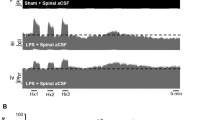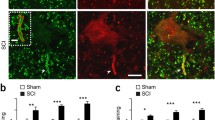Abstract
Plasminogen activators play an important role in synaptic plasticity associated with the crossed phrenic phenomenon (CPP) and recovery of respiratory function after spinal cord injury. A genetic approach using knockout mice lacking various genes in the plasminogen activator/plasmin system has shown that induction of urokinase plasminogen activator (uPA) is required during the first hour after a C2-hemisection for the acquisition of the CPP response. The uPA knockout mice do not show the structural remodeling of phrenic motor neuron synapses characteristic of the CPP response. As shown here uPA acts in a cell signaling manner via binding to its receptor uPAR rather than as a protease, since uPAR knockout mice or knock-in mice possessing a modified uPA that is unable to bind to uPAR both fail to generate a CPP and recover respiratory function. Microarray data and real-time PCR analysis of mRNAs induced in the phrenic motor nucleus after C2-hemisection in C57Bl/6 mice as compared to uPA knockout mice indicate a potential cell signaling cascade downstream possibly involving β-integrin and Src, and other pathways. Identification of these uPA-mediated signaling pathways may provide the opportunity to pharmacologically upregulate the synaptic plasticity necessary for recovery of phrenic motoneuron activity following cervical spinal cord injury.




Similar content being viewed by others
References
Baramova EN, Bajou K, Remacle A, L’Hoir C, Krell HW, Weidle UH, Noel A, Foidart JM (1997) Involvement of PA/plasmin system in the processing of pro-MMP-9 and in the second step of pro-MMP-2 activation. FEBS Lett 405:157–162
Baranes D, Lederfein D, Huang YY, Chen M, Bailey CH, Kandel ER (1998) Tissue plasminogen activator contributes to the late phase of LTP and to synaptic growth in the hippocampal mossy fiber pathway. Neuron 21:813–825
Blasi F, Carmeliet P (2002) uPAR: a versatile signaling orchestrator. Nat Rev Mol Cell Biol 3:932–943
Castro-Moure F, Goshgarian HG (1997) Morphological plasticity induced in the phrenic nucleus following cervical cold block of descending respiratory drive. Exp Neurol 147:299–310
Collen D (1980) On the regulation and control of fibrinolysis. Thromb Haemost 43:77–89
Connolly BM, Choi EY, Gårdsvoll H, Bey AL, Currie BM, Chavakis T, Liu S, Molinolo A, Ploug M, Leppla SH, Bugge TH (2010) Selective abrogation of the uPA-uPAR interaction in vivo reveals a novel role in suppression of fibrin-associated inflammation. Blood 116:1593–1603
Dano K, Romer J, Nielsen BS, Bjorn S, Pyke C, Rygaard J, Lund LR (1999) Cancer invasion and tissue remodeling—cooperation of protease systems and cell types. APMIS 107:120–127
Degryse B, Renati M, Rabbani S, Villa A, Faziolli F, Blasi F (1999) Src-dependence and pertussis-toxin sensitivity of uPAR-dependent chemotaxix and cytoskeleton reorganization in rat smooth muscle cells. Blood 94:649–662
Dewerchin M, Nuffelen AV, Wallays G, Bouche A, Moons L, Carmeliet P, Mulligan RC, Collen D (1996) Generation and characterization of urokinase receptor-deficient mice. J Clin Invest 97:870–877
Friedman GC, Seeds NW (1995) Tissue plasminogen activator mRNA expression in granule neurons coincides with their migration in the developing cerebellum. J Comp Neurol 360:658–670
Goshgarian HG (2003) The crossed phrenic phenomenon: a model for plasticity in the respiratory pathways following spinal cord injury. J Appl Physiol 94:795–810
Hayden SM, Seeds NW (1996) Modulated expression of plasminogen activator system components in cultured cells from dissociated mouse dorsal root ganglia. J Neurosci 16:2307–2317
Huang YY, Bach ME, Lipp HP, Zhuo M, Wolfer DP, Hawkins RD, Schoonjans L, Kandel ER, Godfraind JM, Mulligan R et al (1996) Mice lacking the gene encoding tissue-type plasminogen activator show a selective interference with late-phase long-term potentiation in both Schaffer collateral and mossy fiber pathways. Proc Natl Acad Sci USA 93:8699–8704
Keski-Oja J, Lohi J, Tuuttila A, Tryggvason K, Vartio T (1992) Proteolytic processing of the 72,000-Da type IV collagenase by urokinase plasminogen activator. Exp Cell Res 202:471–476
Krystosek A, Seeds NW (1981) Plasminogen activator secretion by granule neurons in cultures of developing cerebellum. Proc Natl Acad Sci USA 78:7810–7814
Liou WW, Goshgarian HG (1997) The superimposed effects of chronic phrenicotomy and cervical spinal cord hemisection on synaptic cytoarchitecture in the rat phrenic nucleus. Exp Neurol 145:258–267
Mars WM, Zarnegar R, Michalopoulos GK (1993) Activation of hepatocyte growth factor by the plasminogen activators uPA and tPA. Am J Pathol 143:949–958
Mataga N, Mizuguchi Y, Hensch TK (2004) Experience-dependent pruning of dendritic spines in visual cortex by tissue plasminogen activator. Neuron 44:1031–1041
Mazzieri R, D’Alessio S, Kenmoe RK, Ossowski L, Blasi F (2006) An uncleavable uPAR mutant allows dissection of signaling pathways in uPA-dependent cell migration. Mol Biol Cell 17:367–378
McGuire PG, Seeds NW (1990) Degradation of underlying extracellular matrix by sensory neurons during neurite outgrowth. Neuron 4:633–642
Minor KH, Seeds NW (2008) Plasminogen activator induction facilitates recovery of respiratory function following spinal cord injury. Mol Cell Neurosci 37:143–152
Minor KH, Akison LK, Goshgarian HG, Seeds NW (2006) Spinal cord injury-induced plasticity in the mouse—the crossed phrenic phenomenon. Exp Neurol 200:486–495
Monaghan-Benson E, McKeown-Longo PJ (2006) Urokinase-type plasminogen activator receptor regulates a novel pathway of fibronectin matrix assembly requiring Src-dependent transactivation of epidermal growth factor receptor. J Biol Chem 281:9450–9459
Muller CM, Griesinger CB (1998) Tissue plasminogen activator mediates reverse occlusion plasticity in visual cortex. Nat Neurosci 1:47–53
Nakajima K, Reddington M, Kohsaka S, Kreutzberg G (1996) Induction of urokinase-type plasminogen activator in rat facial nucleus by axotomy of the facial nerve. J Neurochem 66:2500–2505
Naldini L, Tamagnone L, Vigna E, Sachs M, Hartmann G, Birchmeier W, Daikuhata Y, Tsubouch H, Blasi F, Comomgilo PM (1992) Extracellular proteolytic cleavage by urokinase is required for activation of hepatocyte growth factor/scatter factor. EMBO J 11:4825–4833
O’Hara TE Jr, Goshgarian HG (1991) Quantitative assessment of phrenic nerve functional recovery mediated by the crossed phrenic reflex at various time intervals after spinal cord injury. Exp Neurol 111:244–250
Oray S, Majewska A, Sur M (2004) Dendritic spine dynamics are regulated by monocular deprivation and extracellular matrix degradation. Neuron 44(6):1021–1030
Pang PT, Teng HK, Zaitsev E, Woo NT, Sakata K, Zhen S, Teng KK, Yung WH, Hempstead BL, Lu B (2004) Cleavage of pro-BDNF by tPA/plasmin is essential for long-term hippocampal plasticity. Science 306:487–491
Pittman RN (1985) Release of plasminogen activator and a calcium-dependent metalloprotease from cultured sympathetic and sensory neurons. Dev Biol 110:91–101
Qui K, Lane MA, Lee KZ, Reier PJ, Fuller DD (2010) Phrenic motor nucleus in the adult mouse. Exp Neurol 226:254–258
Seeds NW, Williams BL, Bickford PC (1995) Tissue plasminogen activator induction in Purkinje neurons after cerebellar motor learning. Science 270:1992–1994
Seeds NW, Basham ME, Haffke SP (1999) Neuronal migration is retarded in mice lacking the tissue plasminogen activator gene. Proc Natl Acad Sci USA 96:14118–14123
Seeds NW, Basham ME, Ferguson JE (2003) Absence of tissue plasminogen activator gene or activity impairs mouse cerebellar motor learning. J Neurosci 23:7368–7375
Seeds NW, Akison L, Minor K (2009) Role of plasminogen activator in spinal cord remodeling after spinal cord injury. Respir Physiol Neurobiol 169:141–149
Siconolfi LB, Seeds NW (2001a) Induction of the plasminogen activator system accompanies peripheral nerve regeneration after sciatic nerve crush. J Neurosci 21:4336–4347
Siconolfi LB, Seeds NW (2001b) Mice lacking tPA, uPA, or plasminogen genes showed delayed functional recovery after sciatic nerve crush. J Neurosci 21:4348–4355
Siconolfi LB, Seeds NW (2003) Mice lacking tissue plasminogen activator and urokinase plasminogen activator genes show attenuated matrix metalloproteases activity after sciatic nerve crush. J Neurosci Res 74:430–434
Thewke DP, Seeds NW (1996) Expression of hepatocyte growth factor/scatter factor, its receptor, c-met, and tissue plasminogen activator during development of the murine olfactory system. J Neurosci 16:6933–6944
Verrall S, Seeds NW (1989) Characterization of 125I-tissue plasminogen activator binding of cerebellar granule neurons. J Cell Biol 109:265–271
Watson C, Harvey A (2009) Projections from the brain to the spinal cord. In: Watson C, Paxinos G, Kayalioglu G (eds) The spinal cord. Academic Press, San Diego, CA, pp 168–179
Zimmer MB, Goshgarian HG (2005) Spontaneous crossed phrenic activity in the neonatal respiratory network. Exp Neurol 194:530–540
Acknowledgments
The authors greatly appreciate the excellent assistance of Karin Layton. These studies were supported in part by a grant from NIH-NS044129 to NWS.
Author information
Authors and Affiliations
Corresponding author
Additional information
This research contribution is dedicated to the memory of a dear friend and mentor Marshall W. Nirenberg, who always said don’t be afraid to explore the big questions in science.
Rights and permissions
About this article
Cite this article
Seeds, N., Mikesell, S., Vest, R. et al. Plasminogen Activator Promotes Recovery Following Spinal Cord Injury. Cell Mol Neurobiol 31, 961–967 (2011). https://doi.org/10.1007/s10571-011-9701-6
Received:
Accepted:
Published:
Issue Date:
DOI: https://doi.org/10.1007/s10571-011-9701-6




